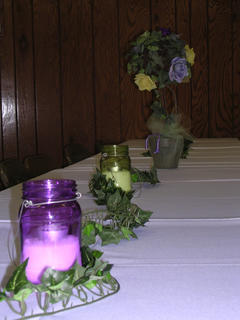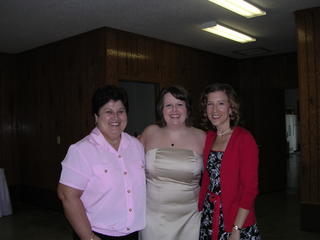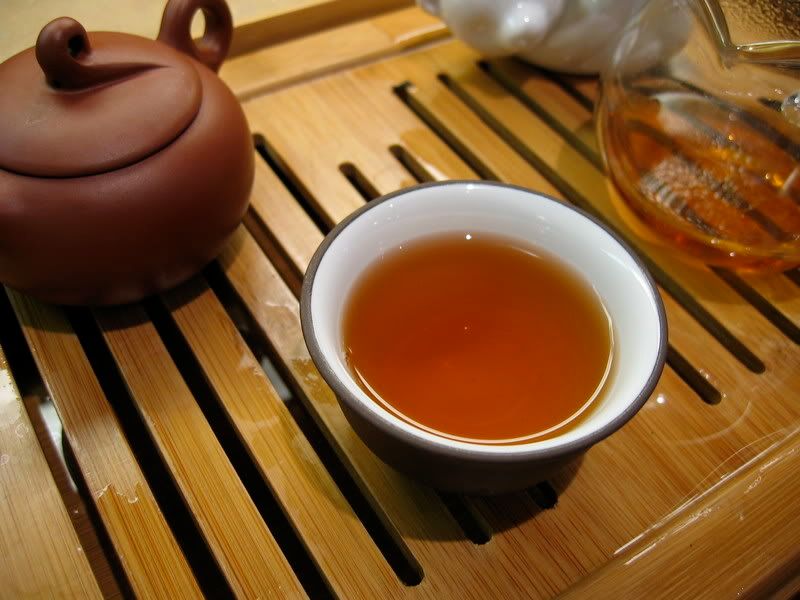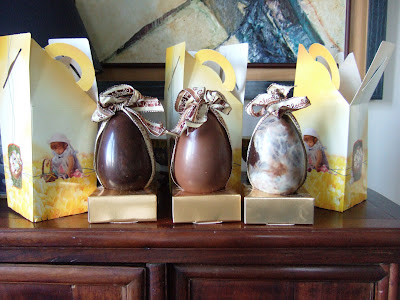The Meaning of Tea is a film, a book and a growing cottage industry created by Scott Chamberlin Hoyt. The feature-length documentary has been methodically making the rounds since its 2008 premiere, followed by a book of transcribed interviews from the film, plus a CD of the film's music, an extra short film and possibly more to come. It's Hoyt's first film; his previous experience, perhaps no surprise, is rooted in his business degrees.
I've been meaning to write about these projects for almost a year. I've wrestled with them. I’ve nurtured a love-hate relationship with them (the love is winning). The mission of Hoyt’s project strikes very close to my heart, to the mission of this blog. I’m not overly interested in reviewing teas here; the critical faculty is usually the last thing I want to bring to the tea moment. I’m also interested in, yes, the meaning of tea. But I still don’t really know what that … means. And, in tea as in many other things, I’m naturally skeptical of anyone who attempts to pin a name on the unnameable. Thankfully — as I discovered in an interview yesterday morning with Hoyt — he had no such delusions when he set out to create a film of surprising grandeur.
The book came to me first, and I was immediately concerned. The text comprises the transcripts of interviews conducted for the film with some cursory connective tissue in the form of a few florid introductory essays and some fairly disposable prose at the beginning of each geographical section (India, Morocco, Japan, etc.). Transcripts being transcripts, there’s no real narrative to the book. It's great supplemental material to the film, but it's a lot to take in on its own. The reader has to drink a lot of average tea, as it were, to filter out the good bits. I decided not to comment until I’d seen the film, seen what portions of all these words the filmmaker would present on screen as his narrative. It’s the editor in me: Don’t give me your notes, give me your
story.
The film succeeds by beautifully failing to define the meaning of tea. I swear that’s a compliment. Explaining the meaning of tea is the proverbial task of nailing smoke to a wall. If Hoyt had concluded something definitive, I would have been disappointed. The film (a good review here) is a colorful, slightly abstract quilt, knitted together from the commentary and impressions of everyday teafolk around the world. We hear from tea growers and tea sellers and tea drinkers — common people, which is important; it’s almost a Howard Zinn approach to tea! — about what tea means to them. The answers are different enough to be interesting and similar enough to be engaging. The film ultimately succeeds by allowing readers to drift in and out of the locales and draw their own conclusions.
v/_nsJXeT6EtY
My conversation with Hoyt, via telephone from his New York City office, was illuminating, particularly on the philosophical front. Here’s a portion of our Q&A:
t2: Your first film is all about tea. So how’d you first greet tea? Any revelatory moments?
Hoyt: I have no specific memory of the first time I encountered tea. Like most people living in this country, I grew up with iced tea. I never had much of a sweet tooth. I used to love drinking iced tea in the summertime, but I never put sugar into it. A little lemon, maybe. And I had tea and toast when I was not feeling well as a child. I liked the feeling it induced in my body. I liked being clear and calm and energized. But there were no revelations, nothing spectacular.
t2: Surely it had to start somewhere? Did something else lead you to tea?
Hoyt: I went to high school in Vermont, and I was very fortunate to be in a school that offered French and Chinese. I opted for Chinese and — this goes back to the summer of 1969 — and in addition to being exposed to Chinese characters, [a friend] and I embarked on an independent study of the Tao Te Ching, approved by the administration. It was just the two of us over two semesters, and we translated up to chapter 25 character by character. Being exposed to that … had to be part of my connection to tea.
t2: And that stuck with you?

Hoyt: Yeah. I just did a book review of The Way of Tea. One thing that occurred to me while reading the book and reflecting on things written about mind-altering plant substances is that tea, like others, is what religious scholar Houston Smith refers ot as entheogens. It’s a word he coined as an alternative to “psychedelic.” He says these are “virtually non-addictive, mind-altering substances that are approached seriously and reverently,” the inference being that these substances can induce a religious experience, an encounters with the gods, something very deep. … Tea is one of these that aids us in that process, but we don’t gain that or have that experience unless we take time to slow down and encourage some kind of ritual. It has a lot to do with taking time and listening.
t2: It’s all about taking time out, isn’t it?
Hoyt: Taking time is the approach to tea. You have to slow down and do nothing but make the tea and enjoy that process. And it is a process. You don’t just flick on the light switch or boot up the computer to get there. And it doesn’t happen every time. … But the idea behind the Tao is to change with the changes. Slowing down and drinking tea allows us to observe what’s in us and around us, and to become one with the tea.
t2: And you feel you found that in the film?
Hoyt: Yes, because we told the story of ordinary people. The Taoists revered ordinary people. If you listen to the most ordinary people, you will find the sage. That’s one of the reasons I went to Tea, South Dakota.
t2: I was going to ask about that. It seems like an odd distraction in the middle of your story.
Hoyt: I’d been thinking of taking a tour of the heartland for six or seven years to understand the meaning of tea there, and in doing research I discovered there was this town called Tea — and the town was about to celebrate its 100th anniversary. We were filming there during that anniversary celebration. We went there to get a slice of life and show how ordinary people reflected on what tea meant in their lives. We went to older people in the community, figured they’d have memories of a world operating at a slower pace. They were all very excited to have us there. The really had the spirit of tea — aspirit of generosity.
t2: And I have to ask about another location, or lack of it. You feature some folks in Taiwan. But why make a film about tea,
travel the world making it, but not go to mainland China?
Hoyt: It was mostly logistics. I had a great production coordinator from Taiwan who knew where to go and who to talk to there. I simply didn’t know anyone who could take us all over China, which is a big place. It was cheaper and I thought more effective to
travel in one place. I would have liked to have gone many other places, too. We went to India, but only to Darjeeling. I would have loved to have gone to the Caucasus.
Next up for Hoyt: a documentary about a Vermont herb farm, which he says he sees as an extension of his interest in tea — one useful plant to some others. He’s also developing a line of teas.
Taken from http://teasquared.blogspot.com/








 It is no small feat to pick two cups of yellow violet blossoms. They are tiny, delicate, and do not grow in clusters of blossoms. So, one by one, I picked the precious little bits of gold and put them in a secure zip-lock bag. The entire time, I kept one ear and eye tuned to the woods around me (and I didn't wander far away from the fence builder!) so that I could be aware and alert for wild animals like cougars and bears. Coco was my companion and together we enjoyed a yellow violet collecting walk through the woods. At first I used scissors to snip, but found it quicker and faster to bend and pinch with my fingers. By afternoon's end I decided there was enough for a cooking project and put the bags in the ice chest to stay cool.
It is no small feat to pick two cups of yellow violet blossoms. They are tiny, delicate, and do not grow in clusters of blossoms. So, one by one, I picked the precious little bits of gold and put them in a secure zip-lock bag. The entire time, I kept one ear and eye tuned to the woods around me (and I didn't wander far away from the fence builder!) so that I could be aware and alert for wild animals like cougars and bears. Coco was my companion and together we enjoyed a yellow violet collecting walk through the woods. At first I used scissors to snip, but found it quicker and faster to bend and pinch with my fingers. By afternoon's end I decided there was enough for a cooking project and put the bags in the ice chest to stay cool. Of course it was late when we arrived back home, and I was not in the mood to stay up and make violet syrup! To protect the delicate blossoms, I placed them in quart jars and filled them with water. Once lidded, they were placed in the refrigerator so they cold stay fresh and cool.
Of course it was late when we arrived back home, and I was not in the mood to stay up and make violet syrup! To protect the delicate blossoms, I placed them in quart jars and filled them with water. Once lidded, they were placed in the refrigerator so they cold stay fresh and cool. The next morning, after reading a variety of violet syrup recipes, I sent out an SOS to Clarice at Storybook Woods (she's an expert at rose syrup). She gave me a quick phone call (well, it wasn't really quick --- we enjoyed a lovely chat) and we consulted about the best formula options and techniques for delicate floral syrups.
The next morning, after reading a variety of violet syrup recipes, I sent out an SOS to Clarice at Storybook Woods (she's an expert at rose syrup). She gave me a quick phone call (well, it wasn't really quick --- we enjoyed a lovely chat) and we consulted about the best formula options and techniques for delicate floral syrups.


 Britain is big on tradition, from the changing of the guard at Buckingham Palace (I can still remember seeing the soldiers going through the same carefully laid-out movements that they had done for decades) to their breakfast. Cereals play a big part, as they have for about as long as those guards have been changing.
Britain is big on tradition, from the changing of the guard at Buckingham Palace (I can still remember seeing the soldiers going through the same carefully laid-out movements that they had done for decades) to their breakfast. Cereals play a big part, as they have for about as long as those guards have been changing.

 “What’s a tea station?” you query. Good question. Thought you’d never ask.
“What’s a tea station?” you query. Good question. Thought you’d never ask.


 Dry Leaf:
Dry Leaf: This was a nice, dark flavored dessert kind of tea. Not necessarily dark in color, as you can see, but dark in flavor, with a consistent blend of smooth dark chocolate and red berries. I picked up almost no smokiness whatsoever, which was unexpected because of all the roasting this tea has experienced. Though the aroma had hints of cherries (thanks again Sal), I thought the
This was a nice, dark flavored dessert kind of tea. Not necessarily dark in color, as you can see, but dark in flavor, with a consistent blend of smooth dark chocolate and red berries. I picked up almost no smokiness whatsoever, which was unexpected because of all the roasting this tea has experienced. Though the aroma had hints of cherries (thanks again Sal), I thought the  Wet Leaves:
Wet Leaves:
 Out with the old and in with the new — year, that is! Try something different to toast in that new year: the champagne of teas — Darjeeling. Don’t forget the feast to go with it. Get the details on The Taste of English Tea Blog.
Out with the old and in with the new — year, that is! Try something different to toast in that new year: the champagne of teas — Darjeeling. Don’t forget the feast to go with it. Get the details on The Taste of English Tea Blog.
 getaway trip to San Francisco, hoping that the fresh ocean air and Union Square shopping would help clear my head. When all else failed, we got cozy with Manhattans at the Clock Bar, and then treated ourselves to a well-deserved mid-afternoon nap.
getaway trip to San Francisco, hoping that the fresh ocean air and Union Square shopping would help clear my head. When all else failed, we got cozy with Manhattans at the Clock Bar, and then treated ourselves to a well-deserved mid-afternoon nap.

















 Hoyt: Yeah. I just did a book review of The Way of Tea. One thing that occurred to me while reading the book and reflecting on things written about mind-altering plant substances is that tea, like others, is what religious scholar Houston Smith refers ot as entheogens. It’s a word he coined as an alternative to “psychedelic.” He says these are “virtually non-addictive, mind-altering substances that are approached seriously and reverently,” the inference being that these substances can induce a religious experience, an encounters with the gods, something very deep. … Tea is one of these that aids us in that process, but we don’t gain that or have that experience unless we take time to slow down and encourage some kind of ritual. It has a lot to do with taking time and listening.
Hoyt: Yeah. I just did a book review of The Way of Tea. One thing that occurred to me while reading the book and reflecting on things written about mind-altering plant substances is that tea, like others, is what religious scholar Houston Smith refers ot as entheogens. It’s a word he coined as an alternative to “psychedelic.” He says these are “virtually non-addictive, mind-altering substances that are approached seriously and reverently,” the inference being that these substances can induce a religious experience, an encounters with the gods, something very deep. … Tea is one of these that aids us in that process, but we don’t gain that or have that experience unless we take time to slow down and encourage some kind of ritual. It has a lot to do with taking time and listening. is not as strong as the black. Since it was steeped for only 3 minutes, this allowed the black tea to have strength but the white tea is not steeped long enough to have any bitterness to it. Thus, an overwhelming sweetness is present.
is not as strong as the black. Since it was steeped for only 3 minutes, this allowed the black tea to have strength but the white tea is not steeped long enough to have any bitterness to it. Thus, an overwhelming sweetness is present. I drink this hot, my mouth still feels refreshed instead of dry like other teas leave it. With that being said, I think this tea would make an excellence iced tea.
I drink this hot, my mouth still feels refreshed instead of dry like other teas leave it. With that being said, I think this tea would make an excellence iced tea. much white tea in it, but it still makes a big difference.
much white tea in it, but it still makes a big difference.